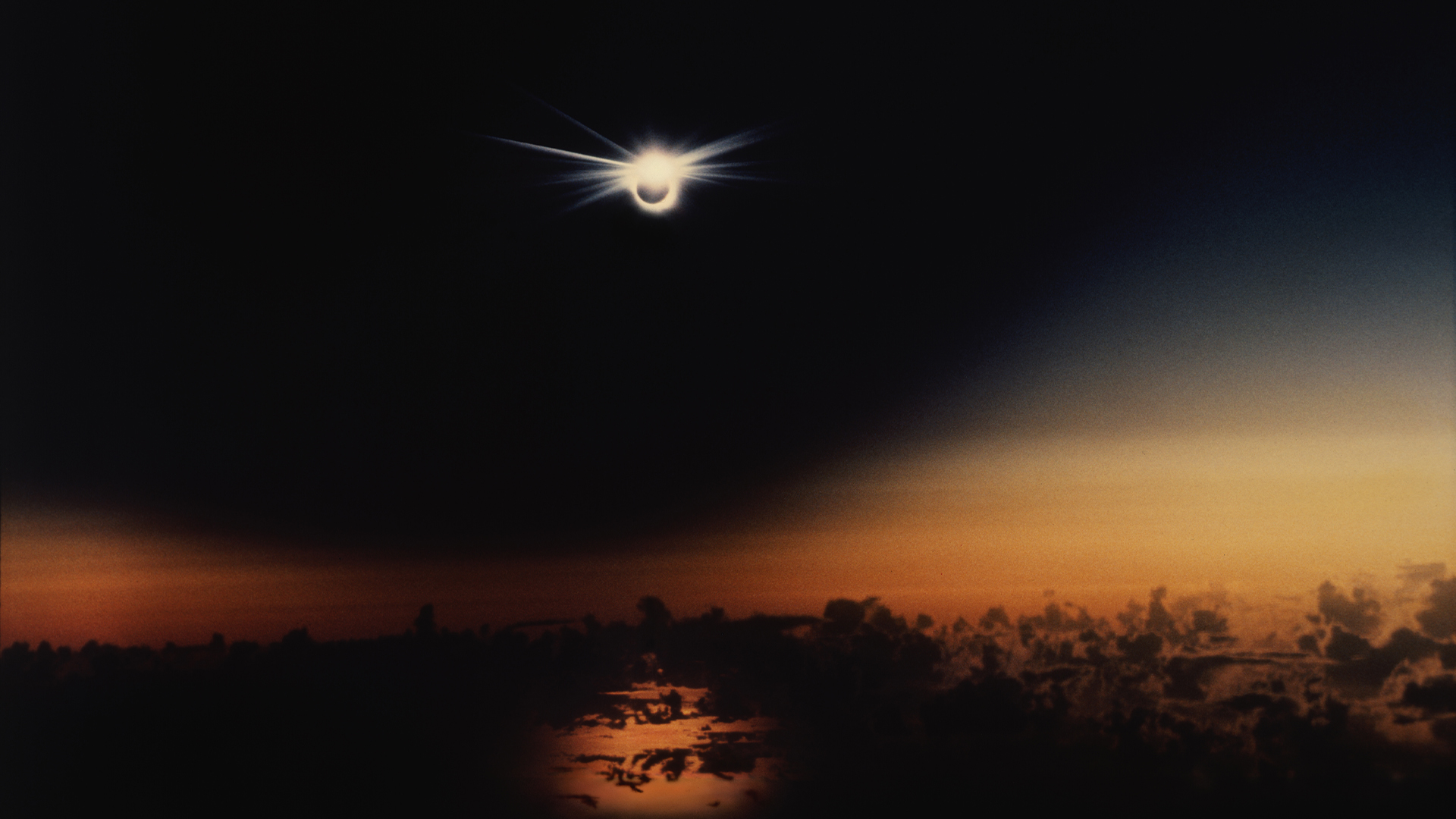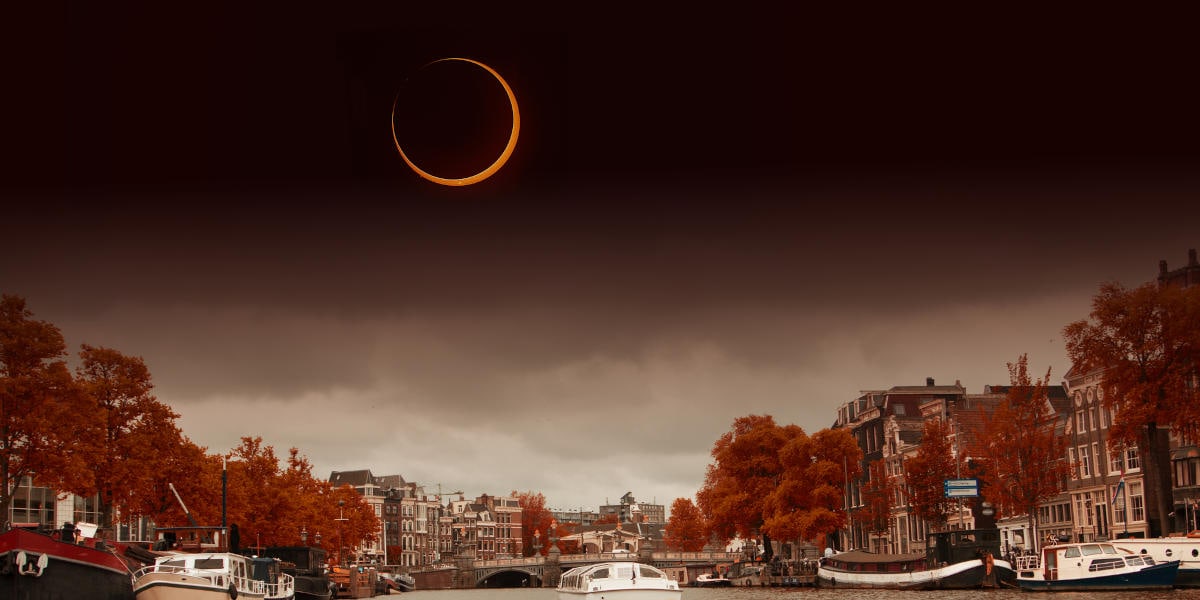Solar Eclipse
What is a solar eclipse—and when is the next one?
Learn the difference between total and partial solar eclipses, how to be in the path of totality, and how to view one safely.
Humans have recorded solar eclipses for millennia, and references to them can be found in some of humanity’s earliest texts, including ancient Chinese historical documents. Debate even swirls around whether a line from Homer's Odyssey—"The sun has been obliterated from the sky"—can be tied to a historic eclipse.
Through the ages, the sudden darkening of the sun has been seen as a signal of the displeasure of the gods or an omen of bad things to come. But once astronomers figured out how solar eclipses worked, they became events to be studied and celebrated.
What they found is that solar eclipses happen only during a new moon, when the moon moves between Earth and the sun. But given there’s a new moon every month, why aren’t solar eclipses more common? That’s because the moon orbits Earth at a slight angle, meaning the three bodies only periodically line up on the same plane to create a solar eclipse.
One of those rare alignments will happen on the night of October 14, when viewers along a narrow path through the Americas will glimpse the sun’s outer edge peeping out behind the moon in an aptly named “ring of fire.” Even if you’re not able to see it for yourself, you can still learn everything you need to know about solar eclipses.
What is a solar eclipse—and how often do they happen?
A solar eclipse occurs when a new moon aligns perfectly between Earth and the sun and briefly casts a shadow on our planet, called an umbra. The moon's diameter and distance from Earth make its relative size just big enough to cover the sun's disk—either partially or fully, depending on the distances between the three celestial bodies.
A total eclipse, when the moon blocks out the entire sun, occurs every one or two years on average. Partial solar eclipses, where the moon covers only part of the sun, are slightly more frequent.

Other types include annular, or ring of fire, eclipses, when a ring of light is visible around the moon, and the rare hybrid eclipses, when an eclipse progresses from annular to total. Annular eclipses occur because the moon’s orbit around the Earth is not a perfect circle, so its distance changes with each orbital cycle.
How long does a solar eclipse last?
Total eclipses are the shortest: Totality, which is the point when the sun is completely blacked out, only lasts between 10 seconds and seven and a half minutes. During this time, some stars and planets become visible and the air temperature drops.
Annular eclipses last less than 10 minutes. While a partial eclipse usually precedes and follows totality, it can also occur on its own, so the length can vary. 
The chance of observing a total eclipse from any single spot on Earth is less than once in a lifetime. That’s because each solar eclipse is only visible from a small area on Earth: As the moon moves and Earth spins, its shadow races across the planet's surface at some 1,400 miles an hour, creating a relatively narrow line called the path of totality. Only sky watchers within this line—typically 10,000 miles long and just a hundred miles wide—experience a total solar eclipse, while others glimpse a partial eclipse or no change at all.
Any given location usually goes an average of 300 years between experiencing an eclipse. Within this century, North America will see three more cross-continental total eclipses: from Mexico through eastern Canada in 2024, from Northern California to Florida in 2045, and from British Columbia to North Carolina in 2099. North Africa and southern Europe will see one in 2027, and Australia in 2028.
The history of solar eclipses, and how they affect Earth
Throughout history, eclipses have helped us learn more about the world we live in.

In 1919, an expedition to watch a total solar eclipse from an island off the west coast of Africa, helped confirm Einstein's general theory of relativity. This theory held that gravity from massive objects should warp the fabric of spacetime and so bend light.
English astronomer Sir Arthur Eddington realized that a total solar eclipse would provide the perfect test bed for this prediction, since light coming from much more distant stars should get bent ever so slightly while passing by the sun—and the eclipse would allow scientists to see stars close enough to the sun's edge to detect this minuscule change. The experiment was a success, and news of the result helped launch Einstein into scientific stardom.
Over the centuries, people who have witnessed eclipses have also noted that animals seem to change their behaviors in response.
One of the earliest stories comes from Italian monk Ristoro d'Arezzo, who described what happened during a total eclipse on June 3, 1239. As the sun disappeared and the sky turned dark, he wrote, “all the animals and birds were terrified; and the wild beasts could easily be caught.”
During an eclipse seen in Portugal on August 21, 1560, astronomer Christoph Clavius wrote that during totality, “stars appeared in the sky and (marvellous to behold) the birds fell down from the sky to the ground in terror of such horrid darkness.”
While it’s hard to confirm such colorful anecdotes from history, modern astronomers and eclipse chasers have also reported wild and domestic animals noticeably reacting to eclipses: Dairy cows return to the barn, crickets begin chirping, birds either go to roost or become more active, and whales breach in the seas. Orb-weaving spiders may also destroy their webs during an eclipse, which a team of researchers attempted to document during an August 2017 eclipse. 
How to safely view one
Seeing a solar eclipse can be an unforgettable experience, but experts urge caution.
Looking directly at the sun with your naked eyes or through unprotected telescopes or binoculars can cause eye damage and even permanent blindness. Special eclipse glasses that filter out the sun's most damaging rays, instruments fitted with solar filters, or simple pinhole cameras can allow you to view the phenomenon safely.
The brief phase of totality is the only time it's safe to look at an eclipse with your naked eyes.

If you have the chance to safely view an eclipse, you should take advantage before it’s too late: Measurements of the distance between Earth and the moon show that our cosmic companion is slowly spiraling away from us, and in a billion years or so, the moon will have drifted so far from Earth that total solar eclipses will no longer occur.
Source
https://en.wikipedia.org/wiki/Solar_eclipse
https://science.nasa.gov/eclipses/future-eclipses/eclipse-2024/
https://science.nasa.gov/solar-system/skywatching/how-is-the-2024-total-solar-eclipse-different-than-the-2017-eclipse/
https://www.timeanddate.com/eclipse/solar-eclipse.html
https://www.exploratorium.edu/eclipse
https://www.space.com/15584-solar-eclipses.html

















































